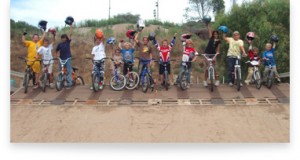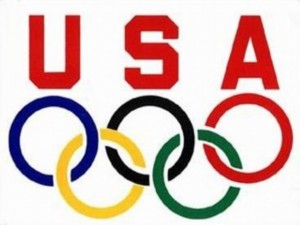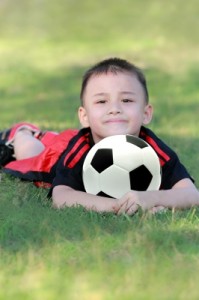By Leslie Dinaberg
Leslie Dinaberg: The 2012 Summer Olympics in London will be your second Olympics. How is it different preparing this time around?

Olympian Todd Rogers, photo by Mitchell Haaseth/NBC
Todd Rogers: I wouldn’t say it feels different. … As far my training and that kind of thing go, its business as usual. There’s no real reason for us to change anything dramatically. The only thing that I try and always keep in mind is that I’m getting older, so just being intelligent about stretching and icing and just taking care of my body because I’m not as durable as I was four years ago.
LD: What percentage of your training is running and lifting versus actually playing volleyball?
TR: The majority these days is probably more running and lifting. I start lifting in November and from mid-October I’ll be doing some kind of running or some kind of exercise that has a cardio component. We (Rogers and partner Phil Dalhausser) really don’t start hitting the ball around until late January early February, there’s just not much reason to do so at a really early stage. The season gets started in April but for us the Olympics are not until August.
I hear of people hitting the ball around in November and I go, “Are you crazy?” But to each his or her own, I guess. I’m kind of a burnout athlete, I’ve discovered that about myself. I just can’t do that much, otherwise I will be sick of the sport.
LD: But you still travel and compete in other places before you go to London.
(Editor’s note: since this interview in April, Rogers/Dalhausser won their third straight gold at the 2012 Brasilia Open and retained their Shanghai Grand Slam title. They are currently competing in Beijing. For a complete tournament schedule click here.)
When you are doing all of that traveling, how much of those places are you getting to see? Are you getting to play tourist at all?

Olympian Todd Rogers, photo by Mitchell Haaseth/NBC
TR: At some of them we have. A lot of them are re-stops, so for example I’ve been to Klagenfurt, Austria, which is probably the best tournament in the world, probably ten times. I’ve done well most of the time but not all the time, and when I haven’t done well I’ve gone out and checked out the city. It’s on a lake so I’ve gone on boats and whatnot… When we were in Berlin I made it a point to just kind of check out the surrounding area. There have been a few stops where I stay a couple of days extra just because it’s a really cool place. Like in Prague, there are some just really neat areas in Prague that are really old and I make a point of making sure that I get to those and check them out and try to find something new in those areas.
LD: I know you grew up in Santa Barbara and went to San Marcos High School and UCSB. Growing up near the beach is so unique. When you are playing volleyball internationally is it different playing on an actual beach versus some place where they bring sand in?
TR: I would say yes, absolutely. On an actual beach, if you know the beach, you have a consistent wind. The sand tends, not always, but tends to be deeper. When they bring in the man made court they are looking at trying to save money and it costs money to bring sand so they are going to put really the minimal amount of sand they can put in to save costs … it’s much more of a jumper’s sand.
There’s definitely a difference and especially if you’re in a city between buildings. The winds are really weird. It could be going one way and then ten minutes later it could be going the other way because just the way it goes through the buildings can change dramatically really quickly. Whereas on the beach, if you’re at East Beach, most of the time the wind in the afternoon blows out of the northwest. I know that.
LD: When did you start playing beach volleyball?
TR: When I was at San Marcos High School. John Lee was the coach there for the volleyball team; he’s also an English teacher. He encouraged all of us freshman boys, actually pretty much all of his volleyball protégées to just go down to East Beach and play. He said, “You’ll become a much better indoor player if you go and play on the beach.”
It’s a lot of fun. We were all 14-year-old boys. You’ve got lots of girls in bikinis down there, you’ve got your shirt off, you’re running around in your shorts—it was a pretty easy sell for us!
So a bunch of us just started going down there after my freshman year and I was 14-years-old and I fell in love with it right away. And I haven’t stopped playing. I didn’t stop playing when I was in college and just kept going with it.
LD: I know you have a son and a daughter (Nate, age 11 and Hannah, age 13). Are they volleyball players?
TR: My daughter loves it; she actually particularly loves beach volleyball. My son enjoys playing beach volleyball but he’s not super into it. We have a court in our backyard (Rogers and his wife Melissa live in Solvang) so we actually play a fair amount of family volleyball. It used to be kind of even, but my daughter at 13 has gotten a lot better in the last year. My son at almost 11 has not. So it’s kind of getting to an unfair level, but he’ll still play. It’s a fun family activity.
LD: You must have other people come and use your court.
TR:We always have people over and I usually have one or two foreign teams that are friends of ours that

Olympian Todd Rogers, photo by Mitchell Haaseth/NBC
play on the international tour and they come to California to train and we’ll come up here. We’ll have a little barbecue after and just kind of hang out, have a few beers, that kind of thing.
We have some friends in town that kind of hang out, their kids come over and play with our kids there or we’ll set up a few trainings with some of the kids and there’s a couple of adults that like to come over and hack it, have a good time. Usually it involves a couple of beers, though. (Laughs)
LD: I know you and Phil have already qualified for the Olympics, but assuming other Americans qualify, then you also could conceivably be competing against those people. What’s that like?
TR: It is a little different because it’s really funky the way they do it. There’s a four year window, say after the Olympics, you have your following next two years when you’re just playing on the international tour and that’s how you qualify and everyone is kind of cheering for each other. I’m always cheering for other Americans of course, unless I’m playing.
Then all of a sudden January 1, 2011 comes along and now, as happens every four years, all of a sudden you are competing against those people just to make the Olympics. So you still want them to win because they are your friends, but at the same time you want to make sure that you are doing a lot better.
Phil and have been very fortunate in that we have done well right away where we have kind of separated ourselves from our competitors …They are fighting it out amongst each other and we just are watching it. We’re pretty much already in. … now the other two teams that are fighting for the spot they’re super close and they can’t catch us so it’s like we can just sit back and just enjoy it. I’ll cheer for them, unless we’re playing against each other.
In the Olympics it’s the same kind of thing. It’s like I want to see them do well, so I’m cheering for them, but at the same time I want to ultimately win the gold medal over them if that’s what it comes down to.
LD: At this point in your career, what percentage of your skill is physical versus mental?
TR: At this point it’s almost all just a mental game for me. Keeping my body healthy, no doubt, that’s the number one thing on the physical side of things and then the rest of it is just I know what I’ve got to do, I know what I need to accomplish and most of that’s just mental. In fact Coach Lee always used to tell me and other players that the game of volleyball is 90% mental and 10% physical. That might be an extreme but it’s pretty darn close. It’s definitely more of a mental game than a physical game.
As I’ve aged and as I’ve seen my kids play and I’ve coached at UCSB and whatnot and I’ve come to realize that he’s absolutely correct. There are kids that are just jumping out of the gym and are amazing athletes and yet they’re just not very good because in the mental part they just break down they make a lot of foolish errors that are really mental errors and not physical errors. They are jumping eight inches higher than the other kids but the other kids are consistent, play smart, using their eyes and their brain and thinking okay I need to do this rather than this, whereas a lot of those exceptional athletes will just use their athleticism and at some point in their careers they are going to meet someone who’s relatively close or maybe even better than them that can’t get past that because they haven’t really developed their mental game.
So I’m fortunate in that I was able to develop that mental game and have decent physical skills, not as great as a lot of other people’s but definitely the mental side of things is so important. I am fortunate that I have that.
LD: Has volleyball always been your favorite sport?
TR: No, not really. It was actually soccer. I played soccer since I was four or five years old. I always thought that was my sport and I loved it. Even into high school when I started playing volleyball and beach volleyball, soccer was always my sport, my first love.
Coach Lee was always like, “man you’ve got to play club volleyball.” And I was always like, “No man, soccer is my sport, I’m not going to stop playing soccer.”
Then my senior year I was trying to get scholarships to play soccer and it wasn’t really happening, I could have walked on a couple of places. But some volleyball teams were recruiting me and so I ended up playing at UCSB on the volleyball team. I still went out for the soccer team and made the soccer team my freshman year but after that season I had to recognize that I’m better at volleyball than I am at soccer. And at a collegiate level, soccer is just, these guys are so fast and so quick it’s like they could run forever. I’m reasonably fast and reasonably quick but they just seem like a different type of athlete than me. In high school and below and in volleyball I was right there, one of the better players pretty much all of the time. I just realized that my upside in volleyball was much greater than it was in soccer.
LD: That’s really interesting. To me volleyball and soccer seem like such different sports.
TR: They are, but there is actually a fair amount of crossover. Like for me, trying to stay with a smaller quicker, faster guy, I had to use perfect footwork and everything had to be on balance and all that kind of stuff. I found that actually correlated really well over to particularly playing defense on the beach. Having good balance, recognizing what’s going on, what’s going to happen and being able to anticipate, which was what I had to do in soccer just to essentially stay alive. It became a trick for me on the beach court.
LD: I’ve heard the announcers call you “the professor” before, and I’m getting a little of that from our conversation. What’s that about?
TR: A lot of people said I kind of have a mental black book on everyone, as far what their tendencies are, so one of the announcers, Chris “Geeter” McGee, about ten years ago, he started calling me the professor. I like it. It actually kind of suits. I always looked at the way I play as more of a cerebral game and whenever I’m out there I want to make it into more of a cat and mouse kind of game, because that’s where my strengths lie. I’m not the biggest jumper; I’m not the biggest guy; I’m not the quickest guy. I’m reasonable on all of those areas but I knew that I would be stronger on the cerebral side of things, so it kind of fits me as a person aside from just a nickname.
LD: If you weren’t a professional athlete, what would you be doing?
TR: There’s a good shot that I would be coaching. I really enjoy coaching. I started coaching basically right out of high school, coaching junior high teams, club teams, even some high school ball. I’ve actually continued to kind of coach through my children a little bit on the volleyball but a lot on the AYSO soccer stuff and I’ve enjoyed it.
I do think that kids and people in general have changed a lot and I’ve noticed that as I’ve coached more and more it’s changed in a way that’s a lot harder to coach now. So I’m not as gung ho on it, but I could have seen myself 20 years ago being pretty focused on coaching. Other than that it’s hard to say.
… I’ve gotten into some business stuff and have kind of started to enjoy that as well, and that’s something that I’m going to be seriously looking at and trying to get my hand into some different cookie jars, if you will, so that when I retire, which is right around the corner in the next couple of years or so, I’ve got some active things going that will provide me with income and hopefully that I will enjoy.
LD: So you’re thinking about retirement a little bit?
TR: Yeah, I’m 38 and I turn 39 on September 30, so it’s just the reality of the situation. I’ve really never wanted to play much into my 40s. All of these guys … that have played into their 40s, it seems like their bodies kind of started to break down. They were all still having a lot of fun with it, which obviously in my opinion would be the number one thing, but again, I don’t want to have my body be completely breaking down. It’s hard enough to do a workout and being sore.
Essentially from January to June I feel like I’m sore all of the time because I’m working out hard and I’m playing in tournaments and my body just hurts and I’ve got to get deep tissue and ice and all that stuff. It didn’t seem like it used to be that way.
LD: Do you worry more about injuries more than you used to?
TR: Honestly, I’ve never worried about injuries per se, it’s more taking care of the little things like stretching, icing, getting those deep tissue massages, even soaking in the cold ocean after a long workout, getting up to my weight and soaking my legs. Those kinds of things I’m more cognizant of now, and I do a lot more of. … People will say, “How can you go snowboarding? that could ruin your career.” But you know what, you could step off a sidewalk and get something wrong and your leg locks out and you blow your ACL. I’ve seen it happen before. I just think I’m going to live my life not worried about those kinds of things. I’m not going to do anything extraordinarily stupid, but I’m still going to surf, I’m still going to do the things I enjoy and if I get hurt doing those things then I’m just not going to concern myself with it.
LD: Will your family go with you to London?
TR: That’s the plan … I did not take the kids to Beijing because it was just not very conducive for children. … My wife did come over for the last week so she was there when we won the gold medal and that was very cool. But I figure In London they speak English, there’s a ton of things that are really relevant to our history as Americans having basically a lot of people that started our country coming from Great Britain and London in particular. And there are just so many cool sights to see there.
LD: We’ll all be rooting for you from Santa Barbara. Good luck.
TR: Thanks.
Both men’s and women’s Olympic Beach Volleyball competition starts play in London on July 28. Click here for the complete schedule and more information as items as added.
Look for Leslie Dinaberg’s interview with another Santa Barbara Olympian, water polo player Kami Craig, in the summer issue of Santa Barbara Seasons Magazine, out June 1.
Originally published in Santa Barbara SEASONS on May 18, 2012.















 By
By